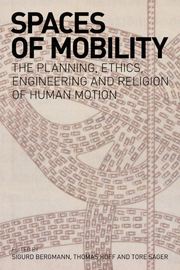Book contents
- Frontmatter
- Contents
- List of illustrations and tables
- Contributors
- Preface
- Acknowledgements
- 1 The beauty of speed or the cross of mobility? Introductory reflections on the aesth/ethics of space, justice and motion
- Part I
- 2 Hypermobility and the forecast-free planning of society
- 3 ‘Green’ attitudes and sustainable household consumption of energy and transport: six conditions that improve attitude–behaviour consistency
- 4 Travelling as pilgrimage: ecotheological contributions to mobility ethics
- Part II
- Part III
- Index
3 - ‘Green’ attitudes and sustainable household consumption of energy and transport: six conditions that improve attitude–behaviour consistency
from Part I
- Frontmatter
- Contents
- List of illustrations and tables
- Contributors
- Preface
- Acknowledgements
- 1 The beauty of speed or the cross of mobility? Introductory reflections on the aesth/ethics of space, justice and motion
- Part I
- 2 Hypermobility and the forecast-free planning of society
- 3 ‘Green’ attitudes and sustainable household consumption of energy and transport: six conditions that improve attitude–behaviour consistency
- 4 Travelling as pilgrimage: ecotheological contributions to mobility ethics
- Part II
- Part III
- Index
Summary
One of the least comfortable themes [of sustainable development] is sustainable consumption. Taken seriously, it is likely to require major changes in the lifestyles of those living in most developed countries – something that none of us finds easy.
(Sir Aaron Klug, President of the Royal Society, in Heap & Kent 2000: iii)In Agenda 21 – the action plan from the Earth Summit in Rio in 1992 – sustainable consumption was presented as a major challenge for achieving sustainable development: ‘the major cause of the continued deterioration of the global environment is the unsustainable pattern of consumption and production, particularly in industrialized countries, which is a matter of grave concern, aggravating poverty and imbalance’ (UN 1992: §4.3). Agenda 21 addresses both consumption and production, which are closely linked. Indeed, it is impossible to imagine the one without the other. This essay focuses on consumption.
What is sustainable consumption? The term ‘sustainable consumption’ is defined along the lines of the World Commission on Energy and Development's definition for sustainable development as ‘the use of goods and services that responds to basic needs and brings a better quality of life, while minimising the use of natural resources and toxic materials, and emissions of waste and pollutants over the life-cycle, so as not to jeopardise the needs of future generations’ (Norwegian Ministry of Environment 1994).
- Type
- Chapter
- Information
- Spaces of MobilityThe Planning, Ethics, Engineering and Religion of Human Motion, pp. 59 - 80Publisher: Acumen PublishingPrint publication year: 2008



